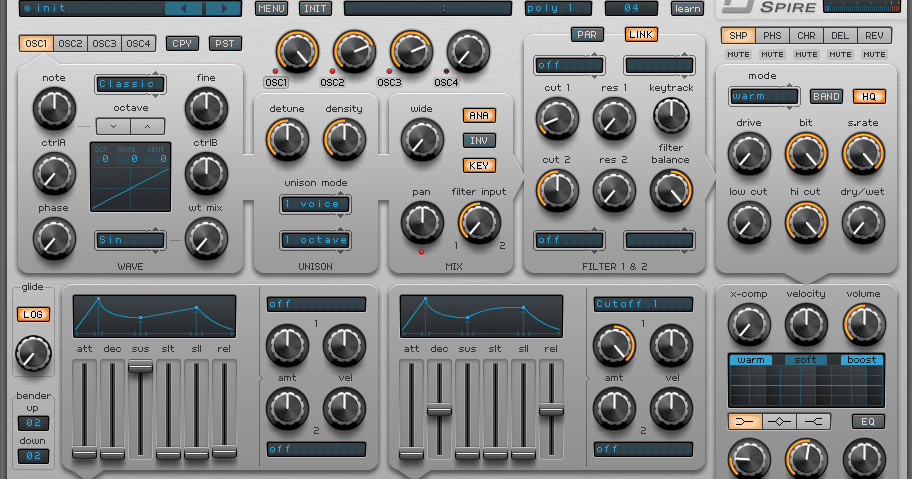
u-he are makers of award-winning software synthesisers and effects including Diva, Repro-1, Zebra2, Hive, Bazille, Presswerk and Satin.
Visit U-he

u-he are makers of award-winning software synthesisers and effects including Diva, Repro-1, Zebra2, Hive, Bazille, Presswerk and Satin.
Visit U-heSynth Secrets is a series of programming tutorials in which we show how to make a range of classic and new synth sounds using plugins such as Massive, Sylenth and Predator.
This time around we’re using Reveal Sound’s Spire subtractive synth to make a classic analogue 80s-style bass sound.
Here’s an example of the sound we’ll be making:
And here’s the MIDI:
Initialise a blank patch by clicking on INIT alongside the top MENU button.
Now fire up the first three oscillators (OSC1, 2 and 3 buttons in the top left panel). By default, Spire allocates new oscillators saw waves (Classic in the top backlit drop-down menu) – which is what we’re after for our thick bass sound.
Navigate right to the OSC volume dials and set OSC1 to the loudest at 100% (1000), with OSC2 and 3 at around 75% volume (750).
To extend the sound into the lower registers and thicken it up, ensure that the OSC1 indicator, top left, is backlit, then transpose OSC1 down two octaves using the ‘octave’ arrows, then fine-tune it by +9 cents (the window beneath ‘octave’ gives numerical feedback).
Use the same process to pitch OSC2 down by 2 octaves and -4 cents, then shift OSC3 down 1 octave and then +6 cents.
Detuning each oscillator in this way serves to thicken up the sound to give the character of older ’80s polysynths. To further increase the sound’s analogue credentials, highlight OSC3 then increase the number of voices to 7 in the menu beneath ‘unison mode’, then turn the ‘wide’ dial to around 500.
Set up a filter in the FILTER 1 & 2 panel by clicking the top left drop-down menu and selecting the acid-style ‘acido’ filter then LP4 in the menu alongside – a raw filter with a dramatic cutoff. Finally, set the ‘cut 1’ filter cutoff dial to 0.
Move down and left to the ENV3 panel, which is set to affect Cutoff 1 by default. To use the filter envelope to shape the sound, set the cutoff amount (‘amt’) to around 980, trimming off some of the sound’s high end.
Now use the envelope faders to set decay (‘dec’) at around 427 (the value is displayed in the readout at the top of the plugin) and sustain (‘sus’) to 365. It’s worth playing with these faders – you can hear how effective automated changes over time would be in an arrangement.
Finally, very slightly increase the value of the attack (‘att’) – somewhere around 50 should do the job. This subtle step smooths out the initial transient of the bass sound so that it interferes less with the ultra-fast transients of drum sounds in the mix, making for a more cohesive low end.
Finally, let’s add some effects in the top right panel. Click on CHR to layer a sheen of chorus – another trademark element of the 80s vibe. The amount you choose to use is up to you and your track’s needs. The critical controls are the ‘dry/wet’ dial, bottom right, and the ‘low cut’ dial, bottom left. Shifting the low cut value up helps avoid an overly blurred low end, while also retaining the chorus effect.
You might also want to experiment with the SHP shaping controls, where saturation and warmth can be added using the ‘mode’ menu and ‘dry/wet’ control.
2nd June, 2015

u-he are makers of award-winning software synthesisers and effects including Diva, Repro-1, Zebra2, Hive, Bazille, Presswerk and Satin.
Download the demos and try them for yourself at www.u-he.com
Attack Magazine is funded by advertising revenue. To help support our original content, please consider whitelisting Attack in your ad blocker software.
x
01.23 AM
For some reason I was not able to have the same sound after checking all specifications to get it =(
06.05 AM
I have the same problem Chris. It still sounds very 80’s tho. But exactly that sound we wanted to reach by following all instructions, didnt end up well.